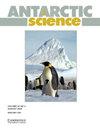利用 DNA 代谢编码评估南极洲海洋乔治王岛凯勒半岛上空的空中生物多样性
IF 2
4区 地球科学
Q3 ENVIRONMENTAL SCIENCES
引用次数: 0
摘要
南极无冰地区主要是随风飘散的生物。然而,人们对哪些生物到达南极并在南极循环以及如何到达和循环仍然知之甚少。由于南设得兰群岛毗邻南美洲,极端条件较少,因此这里的二孢数量可能较多。气候变化的一个可能后果是,新来者将能够在无冰地区定居,从而改变群落组成并影响本地生物群。我们使用 DNA 代谢编码来识别空气中可能到达南极洲并在南极洲流通的非真菌真核 DNA。2019 年 12 月至 2020 年 1 月期间,我们在乔治王岛上的巴西 Comandante Ferraz 南极站附近采集了空气样本。共分配到来自 10 个门类和 3 个王国的 35 个分类群的序列:色界(纤毛虫纲、栉水母纲、栉水母纲和赭石纲)、植物界(叶绿体纲、毛叶植物纲和木兰纲)和动物界(软体动物纲、节肢动物纲和脊索动物纲)。种类最多的是植物(26 个类群),其次是色叶植物(6 个类群)。最多的序列是绿藻衣藻(Chlamydomonas nivalis)。两个被子植物序列代表外来类群;Folsomia 也是外来类群,仅在欺骗岛有记录。元条码揭示了以前未记录的气载多样性的存在,表明南极气孢子虫包括本地和远距离来源的繁殖体。本文章由计算机程序翻译,如有差异,请以英文原文为准。
Assessing aerial biodiversity over Keller Peninsula, King George Island, Maritime Antarctica, using DNA metabarcoding
Antarctic ice-free areas are dominated by wind-dispersed organisms. However, which organisms arrive and circulate in Antarctica and how remain poorly understood. Due to their proximity to South America and less extreme conditions, the South Shetland Islands are likely to receive higher diaspore numbers. One possible consequence of climate change is that newcomers will be able to colonize ice-free areas, altering community compositions and impacting the native biota. We used DNA metabarcoding to identify non-fungal eukaryotic DNA present in the air that could potentially reach and circulate in Antarctica. Air was sampled near the Brazilian Comandante Ferraz Antarctic Station on King George Island between December 2019 and January 2020. Sequences representing a total of 35 taxa from 10 phyla and 3 kingdoms were assigned: Chromista (Ciliophora, Cercozoa, Haptophyta and Ochrophyta), Plantae (Chlorophyta, Bryophyta and Magnoliophyta) and Animalia (Mollusca, Arthropoda and Chordata). The most diverse group were the plants (26 taxa), followed by Chromista (6 taxa). The most abundant sequences represented the green algae Chlamydomonas nivalis . The two angiosperm sequences represent exotic taxa; Folsomia is also exotic and was recorded only on Deception Island. Metabarcoding revealed the presence of previously undocumented airborne diversity, suggesting that the Antarctic airspora includes propagules of both local and distant origin.
求助全文
通过发布文献求助,成功后即可免费获取论文全文。
去求助
来源期刊

Antarctic Science
地学-地球科学综合
CiteScore
3.60
自引率
6.20%
发文量
42
审稿时长
3 months
期刊介绍:
Antarctic Science provides a truly international forum for the broad spread of studies that increasingly characterise scientific research in the Antarctic. Whilst emphasising interdisciplinary work, the journal publishes papers from environmental management to biodiversity, from volcanoes to icebergs, and from oceanography to the upper atmosphere. No other journal covers such a wide range of Antarctic scientific studies. The journal attracts papers from all countries currently undertaking Antarctic research. It publishes both review and data papers with no limits on length, two-page short notes on technical developments and recent discoveries, and book reviews. These, together with an editorial discussing broader aspects of science, provide a rich and varied mixture of items to interest researchers in all areas of science. There are no page charges, or charges for colour, to authors publishing in the Journal. One issue each year is normally devoted to a specific theme or papers from a major meeting.
 求助内容:
求助内容: 应助结果提醒方式:
应助结果提醒方式:


